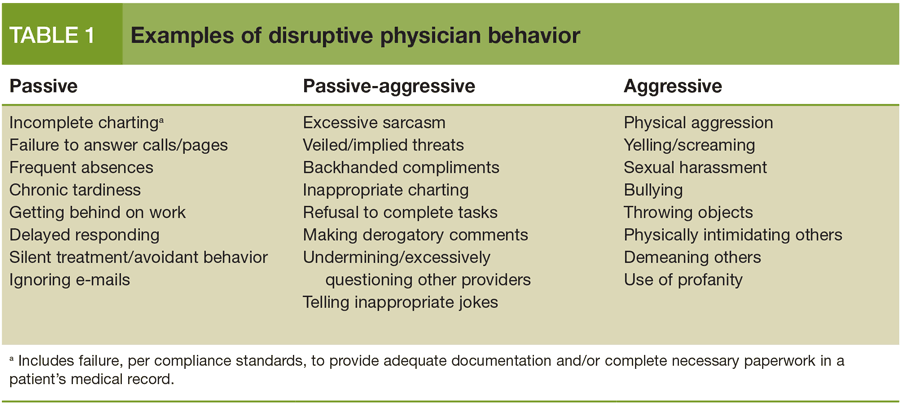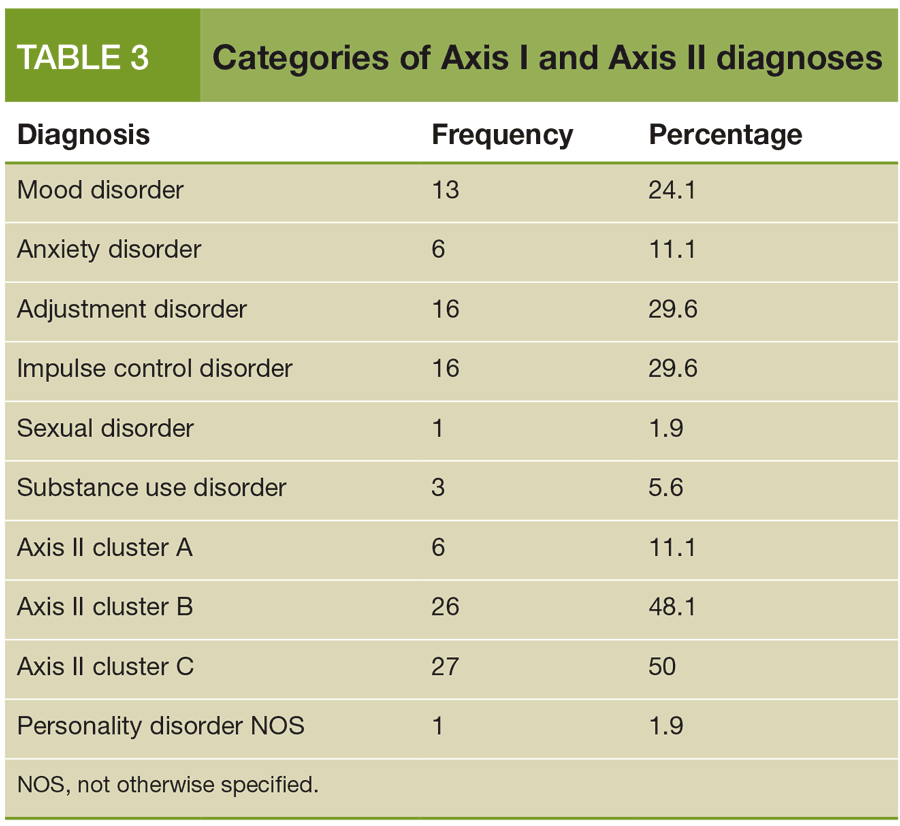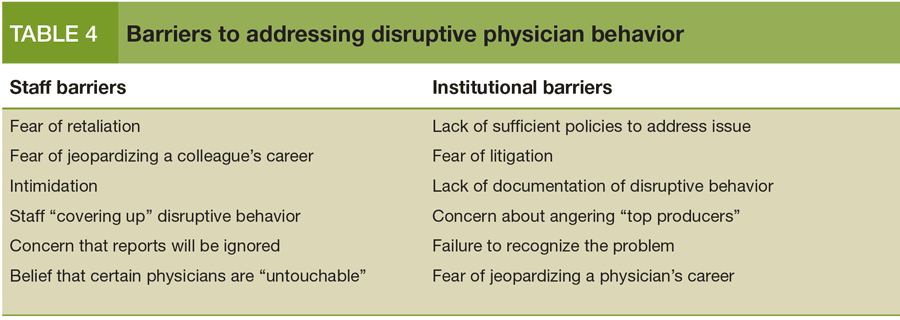Publication
Article
Psychiatric Times
Psychiatric Conditions Affecting Physicians With Disruptive Behavior
Author(s):
This study highlights the need to consider a holistic approach when discussing the problem of disruptive behavior in health care settings.
Table 1: Examples of disruptive physician behavior

Table 2: Consequences of disruptive physician behavior

Table 3: Categories of Axis I and Axis II diagnoses

Table 4: Barriers to addressing disruptive physician behavior

[[{"type":"media","view_mode":"media_crop","fid":"29558","attributes":{"alt":"","class":"media-image media-image-right","id":"media_crop_9372358328473","media_crop_h":"0","media_crop_image_style":"-1","media_crop_instance":"3061","media_crop_rotate":"0","media_crop_scale_h":"94","media_crop_scale_w":"150","media_crop_w":"0","media_crop_x":"0","media_crop_y":"0","style":"float: right;","title":" ","typeof":"foaf:Image"}}]]The recent focus on physician well-being has highlighted the prevalence of burnout, psychological distress, and “disruptive behavior.” However, the prevention and treatment of disruptive physician behavior has been limited by lack of empirical data. Disruptive behavior is a complex construct with no consistent definition. The AMA describes it as “personal conduct, whether verbal or physical, that negatively affects or that potentially may negatively affect patient care,” and the Joint Commission definition includes all “behaviors that undermine a culture of safety.”1,2
Rather than a single incident, disruption generally refers to a pattern of negative behaviors that creates a hostile work environment and impedes patient safety. The most commonly reported behaviors include degrading comments, yelling, and refusing to work with other members of a health care team.3,4 As seen in Table 1, disruptive behavior may fall along a continuum ranging from overly passive to overly aggressive. It is noteworthy that the label of “disruptive behavior” is not typically applied to expressions of concern or constructive criticism when expressed through appropriate channels.
Table 2 lists common consequences of disruptive behavior, including negative patient outcomes and problems for staff in their work environment.5-7 Disruptive behavior may contribute to patient consequences by interfering with necessary communication. One study documented that 64% of pharmacists would simply fill a questionable medication order rather than call to confirm it, to avoid interacting with a disruptive physician.8 Another study reported that 40% of health care professionals have been intimidated into silence regarding questionable medical practice or a potential error because the “offending” physician was disruptive.5 Unfortunately, although the prevalence of physician disruptive behavior is low (3% to 5%), the overall impact is significant, with up to 97% of physicians and nurses experiencing disruptive behavior in their workplace.5 As a result, there has been a call to examine and improve the identification and rehabilitation of distressed/disruptive physicians.
Identifying key risk factors associated with disruptive behavior may improve access to prevention programs or interventions. Clinical experience suggests that many factors contribute to disruptive behavior, including lack of emotional intelligence, lack of awareness, lack of clear boundaries, burnout, unhealthy conflict resolution strategies, substance abuse, poor social skills, medical conditions, and psychiatric distress. However, there is limited information in the literature about the prevalence of psychiatric disorders among physicians referred for disruptive behavior. Our study sought to examine the prevalence of psychiatric disorders among physicians referred to a state monitoring program because of disruptive behavior.
Methods
Following appropriate Institutional Review Board approval, charts for past and current participants in the state monitoring program were reviewed by the monitoring program staff to identify individuals referred for disruptive behavior. Information about the professionals’ demographics, professional specialty, and psychiatric diagnoses was collected, recorded, and shared with the research team. DSM-IV Axis I and Axis II diagnostic information was collected from evaluations conducted by board-certified psychiatrists or licensed psychologists approved by the monitoring program. Reports were based on inpatient or outpatient assessments that included diagnostic interview, psychological testing, and collateral reports. Frequency counts were completed for Axis I and Axis II diagnoses. V codes were not included in the analyses. Because of significant comorbidity and overlap, Axis II diagnoses were grouped by personality disorder clusters for analysis.
Subjects
Although the monitoring program covers professionals from 28 licensing categories (eg, pharmacists, dentists, psychologists), 53 of the 54 professionals referred for disruptive behavior were physicians (52 MDs, 1 DO, 1 massage therapist). The professionals ranged from 29 to 65 years of age (mean, 47.0 years; SD = 8.2), and the majority were men (92.6%). Racial/ethnic background was not reliably reported for 31 (57.4%). However, 18 individuals (33.3%) were described as white, 3 (5.6%) were described as Asian, 1 (1.9%) was described as black, and 1 (1.9%) was described as Latino. The specialties of the physicians included primary care (n = 11, 20.8%), surgeon (n = 13, 24.5%), non-surgical specialist (n = 24, 45.3%), and unspecified (n = 5, 9.4%).
Thirteen subjects (24.1%) had no Axis I diagnosis. Thirty (55.5%) had one Axis I diagnosis, and 11 (20.4%) had multiple Axis I diagnoses. Fifteen (27.8%) had no Axis II diagnoses, traits, or features noted. Eighteen (33.3%) had a diagnosis, traits, or features from one personality disorder cluster noted, and 21 (38.9%) had multiple Axis II diagnostic clusters noted. The personality disorder clusters represented in the study population are presented in Table 3.
Across both Axis I and Axis II diagnoses, only 2 physicians (3.7%) had no diagnosis noted on either Axis I or Axis II. Conversely, 27 physicians (50%) had both Axis I and Axis II diagnoses, traits, and/or features noted. Thirteen physicians (24.1%) had only Axis I diagnoses, whereas 12 physicians (22.2%) had only Axis II diagnoses, traits, and/or features.
Discussion
Most studies that have examined disruptive physician behavior have focused on its incidence and consequences. There are limited data on specific characteristics of physicians referred for disruptive behaviors. A study of physicians referred for boundary violations found that several met criteria for psychiatric diagnoses, such as mood disorders, adjustment disorders, personality disorders, and anxiety disorders.9 The current study demonstrates similar results among physicians referred for disruptive behavior. Specifically, it revealed high comorbidity of psychiatric disorders and disruptive behavior, with 96.2% of the participants in this study obtaining an Axis I and/or Axis II diagnosis, based on a comprehensive assessment by a qualified psychiatrist or psychologist.
Some important limitations should be considered. First, the retrospective nature of the study precludes meaningful conclusions regarding directionality of the link between psychiatric disorders and disruptive behavior. This is particularly a limitation for the diagnosis of adjustment disorder. It is unknown whether this diagnosis was a factor contributing to the disruptive behavior or a consequence of disruptive behavior. Another limitation was the restricted sample, which included participants from only one state’s monitoring program and consisted primarily of male physicians. Finally, because of the nature of the chart review, there was a lack of data regarding the reliability of the psychiatric diagnoses. Although the evaluators are all qualified professionals with expertise in assessment and diagnosis of psychiatric conditions, diagnostic classification is not completely objective.
The role for psychiatrists
Many barriers may prevent staff from referring a disruptive physician for intervention (Table 4). Yet failure to do so compromises patient safety and does a disservice to the disruptive colleague who could benefit from appropriate intervention. This issue is particularly important for psychiatrists, since they may be able to suggest mental health treatment to a disruptive colleague before an adverse event occurs and they may be called on to intervene or evaluate a physician outside their own work environment in cases of disruptive behavior. Recognizing the association between psychiatric disorders and disruptive behavior may assist psychiatrists in identifying appropriate options for treatment and advocating for the disruptive physician to receive appropriate intervention.
When a physician is identified as potentially disruptive, a series of steps should be followed. First, the individual who is intervening (usually a supervisor) must confirm the facts of any concerning incidents. Second, the supervisor should discuss the event with the physician and explain that the behavior was not professional. Third, the supervisor should obtain assurances that the behavior will not recur. Fourth, it is extremely important to document the incident and follow-up conversation in the physician’s personnel file. Finally, the supervisor should closely monitor the physician’s behavior and follow up with observations.
There are 3 levels of disruptive behavior:
• Initial “mild” offenses, such as problems with attendance or charting
• A pattern of repeated low-level offenses or a single egregious behavior, such as throwing objects or inappropriate physical contact
• Behavior(s) that create imminent risk of harm to patients or staff, such as refusal to heed a clear warning that a medical error is about to occur
If a pattern of mild disruptive behavior develops, the physician may benefit from referral to a live continuing medical education workshop for distressed physicians and his or her behavior should be closely monitored. In more severe cases, referral to a physician health program (ie, state monitoring program) is indicated. The physician health program will be able to assist with the appropriate next steps to ensure patient safety and rehabilitation of the physician.
Conclusion
This study highlights the need to consider a holistic approach when discussing the problem of disruptive behavior in health care settings. Given the high prevalence of comorbid psychiatric diagnoses, it is likely that more attention to physician health and wellness could decrease disruptive behavior and its negative impact on quality and patient safety.
Psychiatrists may be in the best position to act as champions in this cause and to help colleagues recognize options for improved mental health. Disruptive behavior prevention programs should assess psychiatric distress and provide referral to treatment to reduce the overall incidence of physician disruptive behavior. Intervention programs include referral for psychiatric evaluation and treatment whenever physicians are referred for disruptive behavior. Finally, all physicians should be encouraged to seek professional care when their physical or mental health is compromised.
Acknowledgment-Funding for this study was provided by the Professionals Resource Network, Inc, an integral arm of the Florida Medical Association.
Disclosures:
Dr Merlo is Assistant Professor in the department of psychiatry, University of Florida, and Director of Research at the Professionals Resource Network, Inc. Ms Sutton is a psychology resident in the department of psychiatry, University of Florida. Ms Conwell is the Chief Administrative Officer at the Professionals Resource Network, Inc. Dr Brown is an Associate Professor in the department of psychiatry, University of Florida, and Assistant Medical Director at the Professionals Resource Network, Inc. The authors report no conflicts of interest concerning the subject matter of this article.
References:
1. American Medical Association. Opinion 9.045-Physicians with disruptive behavior. 2000. http://www.ama-assn.org/ama/pub/physician-resources/medical-ethics/code-medical-ethics/opinion9045.page. Accessed October 23, 2014.
2. The Joint Commission. Leadership standard clarified to address behaviors that undermine a safety culture. 2012. http://www.jointcommission.org/assets/1/6/Leadership_standard_behaviors.pdf. Accessed October 23, 2014.
3. Reynolds NT. Disruptive physician behavior: use and misuse of the label. J Med Regul. 2012;98:8-19.
4. Stecker M, Epstein N, Stecker MM. Analysis of inter-provider conflicts among healthcare providers. Surg Neurol Int. 2013;4(suppl 5):S375-S382.
5. Rosenstein AH, O’Daniel M. A survey of the impact of disruptive behaviors and communication defects on patient safety. August 2008. http://www.mc.vanderbilt.edu/root/pdfs/nursing/ppb_article_on_disruptive.pdf. Accessed October 24, 2014.
6. Saxton R, Hines T, Enriquez M. The negative impact of nurse-physician disruptive behavior on patient safety: a review of the literature. J Patient Saf. 2009;5:180-183.
7. Rosenstein AH, O’Daniel M. Impact and implications of disruptive behavior in the perioperative arena. J Am Coll Surg. 2006;203:96-105.
8. Felps W, Mitchell TR, Byington E. How, when, and why bad apples spoil the barrel: negative group members and dysfunctional groups. Res Organ Behav. 2006;27:175-222.
9. Brooks E, Gendel MH, Early SR, et al. Physician boundary violations in a physician’s health program: a 19-year review. J Am Acad Psychiatry Law. 2012;40:59-66.






